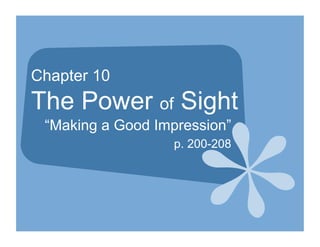
Effective Nonverbal Communication Techniques
- 1. Chapter 10 The Power of Sight “Making a Good Impression” p. 200-208
- 3. Composure/Poise • “The bearing of the head/body” • Presents “ the look of confidence”
- 4. Good Posture • Proper alignment of head, shoulders, & back • Helps establish credibility with audience • Results from proper relaxation & effective concentration
- 5. Visual Directness • Makes good impression • Establishes good rapport • Initial visual contact as you approach platform • Take a relaxed, sweeping glance – Not too slow – uncomfortable look – Not too fast – confused audience
- 6. Approaching/Leaving Stage • Eyes are watching you • First impressions count • Begins as soon as you’re called • Ends when next person is called
- 7. On the Platform • Delivery • Verbal & Nonverbal • How message is delivered • Supports message
- 8. Facial Expression • Conveys meaning to audience • Facial expressions should be “natural” and “expressive”
- 9. Gestures • Nonverbal delivery in movement of limbs or body – Usually moving hands/arms – Shrugging shoulders
- 10. 1st Position of a “Gesture” 1. Approach: Arm comes away from your side & hand moves into position
- 11. 2nd Position of a “Gesture” 2. Hand reaches final destination & stops briefly
- 12. 3rd Position of a “Gesture” 3. The “return” – your hand & arm come back to relaxed, initial position *A gesture can look bad when rushed on approach or return. Relax & take your time!
- 13. Principles for Using Gestures 1. Well timed 2. Large enough to be seen 3. Appropriate for the idea being expressed 4. Varied
- 14. • Distracting, fidgeting hand & arm movements • Holding podium • Hands in pockets • Clasping hands together Remember to keep one (if not holding visual aids) or both hands relaxed at your side when not gesturing.
- 15. Effective Gestures • Well-timed – falls on word/idea being supported • Large enough for entire audience to view –Gesture from elbow, not the wrist • Appropriate for idea expressed – Big gestures for little ideas – Avoid pounding on podium unless emotion demands – Avoid using same gesture repeatedly – Practice before a mirror to preview
- 16. Types of Gestures • Use to accomplish any 4 purposes – To emphasize – To describe – To locate – To transition
- 17. Emphatic Gestures Think “emphasis” – mean what you say! • Oct. 13, 1960: Former Soviet Union leader Nikita Khrushchev took off his shoe and waved it around & banged it on his table in response to another delegate’s claim against during a meeting at the U.N.
- 18. Think “location” – Locative Gestures pointing direction • Show where an object’s located • Direct audience’s attention to a specific object, person, place (book, those women, that room) • Uses index finger or entire hand
- 19. Descriptive Gestures • Speaking about something big, small, round, square • Gives audience an idea to visualize
- 20. Transitional Gestures • Informs audience: Turning to a new idea • Sweeps from one side to another, showing movement
- 21. Remember When Gesturing • Let gestures flow from your thoughts • The more you relax & concentrate on your message • The more natural and effective gestures will be
